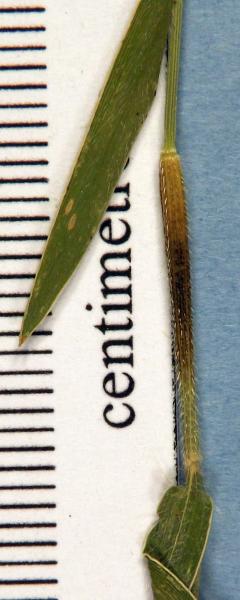Calyptochloa cylindropserma E.J.Thomps. & B.K.Simon, Austrobaileya 8 (4): 644 (2012)
species nova similar to C. gracillima C.E.Hubb. differing by the degree of swelling of the mature fertile leaf sheaths (slightly versus conspicuous) with thinner walls (0.2–0.3 mm versus 0.3–0.5 mm); the longer axillary spikelets (6–7.5 mm versus 3.5–5.5 mm) with longer caryopses (3.8–4 mm versus 2–3.7 mm) and shape (cylindrical versus plano-convex); the longer terminal spikelets (5–6 mm versus 3–5 mm) with longer anthers (2.5–2.6 mm versus 1.6–2 mm) and longer upper glume (5–6 mm versus 2.3–5 mm). Typus: Queensland. North Kennedy District: 16 km SW of Charters Towers on edge of road, 7.5 km W of Black Jack, 30 March 2011, E.J.Thompson CHA769, B.K.Simon & M.Edginton (holo: BRI; iso: CANB, K, L, MO, NSW, SI, US).
Calyptochloa sp. (Blackjack E.J.Thompson+CHA769) (in BRI HERBRECS database accessed July 2012).
Decumbent stoloniferous perennial. Ascending branches to 40 cm tall, copiously branched with 10–30 nodes. Stolons to c. 0.5 m long. Mid-culm leaf blades 15–30 mm long, 2–4 mm wide; adaxial surface with scattered to moderately dense simple hairs to 0.5–1.6 mm long; abaxial surface with moderately dense simple hairs 1–2 mm long. Mature fertile leaf sheaths retained, semi-woody, 15–20 mm long, 1.2–1.7 mm wide near base with wall 0.2–0.3 mm thick; tubercle-based hairs 0.7–1.4 mm long between nerves, simple hairs absent; outer margin hairs to 1 mm long. Fertile culm internodes 20–45 mm long. Sterile leaf sheaths with scattered tuberclebased hairs 0.4–1 mm long nd some simple hairs 0.5–2 mm long. Terminal inflorescences on axes 2–5 cm long, 5–10-flowered. Spikelets 5–6 mm long (without awn), 1.5–2 mm wide; lateral pedicels 0.5–1.5 mm long; ultimate pedicels 3–8 mm long; ultimate spikelets frequently longer than basal spikelets. Lower glume triangular, 0.1–0.5 mm long. Upper glume 5–6 mm long; apex acute. Lower lemma 5–6 mm long; apex acute. Upper lemma body 3–4 mm long, awn to 2.5–4 mm long. Lodicules c. 0.3 mm long. Upper palea 3–4 mm long. Anthers 2.5–2.6 mm long. Caryopsis not seen. Axillary inflorescences enclosed in leaf sheaths within scarcely enlarged basal portion usually present at 3–5 internodes. Spikelets 6–7.5 mm long (without awn), 0.7–0.9 mm wide. Upper glume 0.7–4.5 mm long, apex acute. Lower lemma 6–7.5 mm long. Upper floret subequal to lower. Upper lemma body 6–7.5 mm long, awn 1.5–2.5 mm long. Palea 5.5–6 mm long; acute to shortly awned. Anthers c. 0.6 mm long. Caryopsis cylindrical, 3.8–4 mm long, 0.5–0.6 mm wide.
Distribution and habitat: Calyptochloa cylindrosperma is known from central Queensland near Charters Towers. It usually grows as the dominant ground cover, commonly in woodland of Acacia shirleyi Maiden, with or without A. catenulata C.T.White, on lateritic landscapes on mostly Tertiary plateaux with gently undulating red soil, occasionally jump-ups with shallow soils, or sometimes on shallow soils in sheltered gullies on quartzose sandstone. Associated ground layer species include Cleistochloa subjuncea, Thyridolepis xerophila and Aristida caput-medusae. Regional Ecosystems represented include 10.7.3a and b, and 11.7.2. The habitat is typically well shaded.
Phenology: Calyptochloa cylindrosperma flowers from December to March during the wet season. Axillary spikelets are produced over a broader seasonal period.
Notes: Calyptochloa cylindrosperma is similar to C. gracillima in growth habit and they have been found growing together at the transition of habitat from skeletal soil to deep red soil with the latter habitat occupied by C. cylindrosperma. Only spikelets towards the apex of racemes of terminal inflorescences have a lower glume present; however, it is often absent. Calyptochloa cylindrosperma also has an overlapping distribution and shares habitat with Dimorphochloa sp. (Charters Towers E.J.Thompson+ CHA554). This latter species differs by the terminal spikelets having the upper glume and lower lemma convex in cross-section and the upper floret as long as the spikelet, and the axillary inflorescences consisting of two types, one with paired spikelets, sessile and pedicillate, the other a single sessile spikelet.
Etymology: The specific epithet is from the Greek cylindro- (cylindrical) and -sperma (seed) in reference to the shape of the cleistogamous caryopses.
Conservation status: Calyptochloa cylindrosperma is common at several locations in northern central Queensland but has a very restricted range with narrow habitat diversity. The small populations suggest this species should be considered as Critically Endangered (criterion B1a,b) (IUCN 2001).


